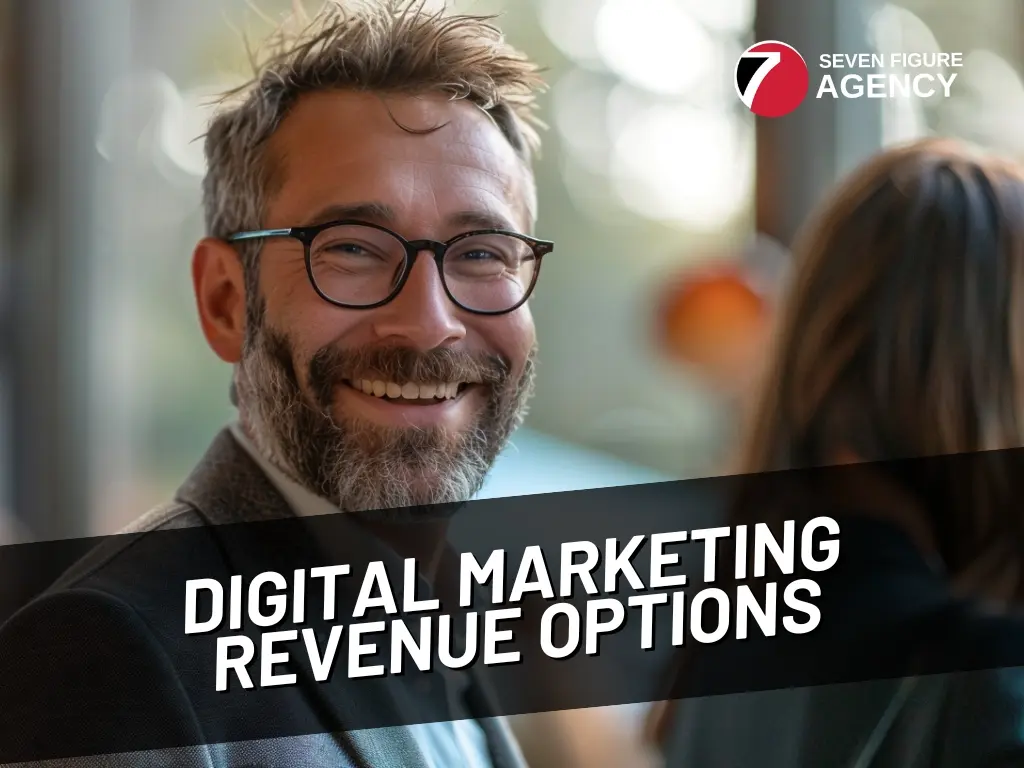In the vast landscape of digital marketing agency revenue, think of your options as different tools in a well-equipped toolbox. Each one serves a unique purpose and can be wielded strategically to maximize profits and client satisfaction.
As you navigate through the various models available—from retainer to equity stake—consider how each can impact your agency’s bottom line and long-term growth. The path you choose could make all the difference in securing success in a competitive industry.
Key Takeaways
- Revenue models align agency incentives with client success.
- Customized packages focus on tangible results for clients.
- Establish steady income streams through clear payment models.
- Build stronger client relationships by delivering value-based services.
Retainer Model
When considering revenue options for your digital marketing agency, the retainer model offers a strategic approach to establishing steady income streams from clients. Retainer flexibility allows you to customize packages based on individual client needs, providing them with the services they require while ensuring a predictable monthly commitment for your agency. This model not only fosters long-term partnerships but also instills trust and loyalty as clients see your agency as a valuable extension of their team.
By offering retainer packages, you can guarantee clients a certain level of service, creating a sense of security and reliability. These service guarantees set clear expectations from the outset, ensuring that both parties are aligned on deliverables and outcomes. Additionally, the retainer model encourages a proactive approach to client relationships, as you continuously work towards achieving their goals and adapting strategies to meet evolving needs.
Building your revenue around retainers can lead to more stable cash flow, allowing you to allocate resources efficiently and plan for future growth. The consistent income from retainers provides a solid foundation for your agency, enabling you to focus on delivering high-quality services without the uncertainty of project-based work. Embracing the retainer model positions your agency as a trusted partner invested in the success of your clients, ultimately driving mutual growth and success.
Performance-Based Pricing
When considering Performance-Based Pricing for your digital marketing agency, it’s crucial to evaluate options like:
- Cost per Acquisition
- Revenue Share Models
- Results-Driven Partnerships
These models can align incentives between your agency and clients, focusing on achieving tangible results. By tying payment to performance metrics, such as conversions or revenue generated, both parties have a vested interest in driving successful outcomes.
Cost per Acquisition
Utilizing a performance-based pricing model such as Cost per Acquisition can provide digital marketing agencies with a clear measure of success tied directly to ROI. By focusing on the cost required to acquire a customer or lead, agencies can align their strategies with tangible outcomes.
This model incentivizes efficiency and effectiveness in campaigns, driving a sharper focus on conversion rates and lead generation. Understanding the specific cost associated with each acquisition allows for better optimization of marketing efforts, leading to improved ROI.
Cost per Acquisition enables agencies to track the direct impact of their campaigns, making it a strategic choice for those seeking data-driven results. Embracing this approach can foster innovation and a more calculated approach to digital marketing strategies.
Revenue Share Models
To enhance revenue potential, consider implementing Revenue Share Models as part of your agency’s pricing strategy. Revenue share models offer both pros and cons.
On the positive side, they align the interests of the agency with the client by linking compensation directly to performance. This can boost motivation and ensure a focus on driving results.
However, it’s crucial to carefully set the revenue share percentage to maintain profitability while providing value to the client. Some revenue share case studies have shown significant success when the model is structured effectively.
Analyzing these case studies can provide valuable insights into how to optimize revenue share agreements for mutual benefit. When considering revenue share models, ensure thorough planning and clear communication to maximize outcomes.
Results-Driven Partnerships
For agencies seeking to align incentives and drive performance, Results-Driven Partnerships offer a strategic approach to pricing based on outcomes achieved. This model focuses on collaborative success and profit sharing, ensuring mutual benefits for both the agency and the client.
Here are some key points to consider:
- Partnership benefits: By forging a results-driven partnership, agencies can demonstrate a strong commitment to delivering tangible client results.
- Client results: This approach puts the client’s success at the forefront, fostering a relationship built on achieving measurable outcomes.
- Collaborative success: Working together towards shared goals can lead to enhanced performance and long-term partnerships.
- Profit sharing: Aligning agency revenue with client success incentivizes both parties to strive for excellence and innovation.
Project-Based Fees
When considering project-based fees for your digital marketing agency, it’s crucial to analyze different fee structures and pricing strategies.
Understanding the intricacies of project-based fees can help you tailor your offerings to align with client needs while ensuring profitability.
Fee Structure Options
Consider structuring your digital marketing agency revenue through project-based fees to ensure a more consistent and transparent payment model. Project-based fees offer numerous benefits for both you and your clients:
- Customized Packages: Tailor services to meet each client’s unique needs.
- Flexible Agreements: Allow for adjustments as projects evolve.
- Variable Rates: Charge based on the scope and complexity of each project.
- Tailored Solutions: Provide personalized strategies for optimal results.
Pricing Strategies
To optimize your digital marketing agency’s revenue potential, implementing strategic pricing strategies such as project-based fees can enhance transparency and flexibility in client payments.
Value-based strategies allow you to align your pricing with the perceived value of your services to the client.
Offering subscription plans can provide a steady stream of income while fostering long-term relationships with clients.
When considering retainer vs. commission-based strategies, assess the needs of your agency and clients to determine the most suitable option.
Project-based fees offer a clear structure for both parties, outlining deliverables and costs upfront.
Hourly Rate
Maximizing your agency’s revenue potential often involves strategically setting an hourly rate that reflects the value of your services in the digital marketing industry. When determining your hourly rate, consider the following key factors to ensure you’re pricing your services competitively and profitably:
- Market Research: Conduct thorough research to understand the average hourly rates charged by digital marketing agencies in your area. This data will provide a benchmark for setting your own rates.
- Skill Level and Expertise: Your agency’s experience, expertise, and the unique value you bring to clients should be reflected in your hourly rate. Clients are often willing to pay more for specialized skills and knowledge.
- Overhead Costs: Factor in your agency’s overhead costs, including salaries, software, tools, and other expenses, when setting your hourly rate to ensure you’re covering all costs and generating a profit.
- Value-Based Pricing: Consider implementing a value-based pricing model where your hourly rate is tied to the specific outcomes and results you deliver for clients. This approach can justify higher rates based on the impact of your services.
Commission-Based
When exploring revenue options for your digital marketing agency, the commission-based model offers a strategic approach to aligning your earnings with the results you deliver for clients. This model ties your compensation directly to the performance of your marketing campaigns, creating a strong incentive to drive successful outcomes. By earning a sales commission based on the leads generated or the sales closed through your efforts, you’re motivated to focus on strategies that yield tangible results.
Performance-based incentives within the commission-based model can be structured in various ways. For example, you could earn a percentage of the total sales generated from a particular marketing campaign, providing a clear link between your efforts and your earnings. Alternatively, you may receive a commission for each lead generated, rewarding you for the effectiveness of your lead-generation strategies. This approach not only ensures that your agency is compensated fairly for its work but also encourages innovation and creativity in developing impactful marketing initiatives.
Embracing a commission-based revenue model can drive a results-driven culture within your agency, where success is directly tied to the outcomes you deliver. By aligning your financial incentives with the performance of your marketing efforts, you can establish a sustainable business model that prioritizes client success and fosters continuous improvement in your digital marketing strategies.
Subscription Model
Considering the evolving landscape of digital marketing, implementing a subscription model can provide a steady stream of revenue for your agency. This model offers numerous benefits and requires strategic pricing strategies to maximize its potential. Here’s a breakdown to help you understand the subscription model better:
- Predictable Revenue: Subscription models provide a predictable income stream, allowing for better financial planning and stability.
- Enhanced Client Relationships: By offering ongoing services through subscriptions, you can build stronger, long-term relationships with clients, increasing loyalty and retention rates.
- Scalability: Subscriptions allow for scalability as you can easily adjust resources based on the number of subscribers, ensuring efficient service delivery.
- Subscription Model vs. Retainer Model: While retainers involve pre-agreed-upon services for a set fee, subscriptions offer ongoing services for a recurring fee, potentially resulting in higher overall revenue due to the continuous nature of subscriptions.
When setting pricing strategies for subscriptions, consider factors such as the value of services provided, competitor pricing, and the perceived value by clients. By carefully structuring your subscription offerings and pricing them competitively, you can capitalize on the benefits of this model while maintaining a sustainable revenue stream for your digital marketing agency.
Value-Based Pricing
To further optimize your digital marketing agency’s revenue potential, exploring value-based pricing can provide a strategic approach to aligning your services with the perceived value of clients. Value-based pricing involves setting prices based on the value your services provide to customers rather than solely on costs or competitor pricing. By implementing value-based pricing strategies, you can capture a fair share of the value you create for your clients, leading to increased profitability and customer satisfaction.
Market research plays a crucial role in determining the value your services offer to clients. Understanding your target market’s needs, preferences, and the benefits they seek from digital marketing services can help you price your offerings accordingly. By conducting thorough market research, you can gain insights into the specific pain points your clients are looking to address, allowing you to tailor your services and pricing to deliver maximum value.
Customer satisfaction is a key driver of success in a value-based pricing model. By aligning your pricing with the perceived value by clients, you can enhance customer satisfaction levels, leading to improved client retention and loyalty. When clients feel that they’re receiving services that are worth the price they pay, they’re more likely to continue working with your agency, ultimately boosting your revenue and profitability.
Cost-Per-Acquisition (CPA)
Cost-Per-Acquisition (CPA) is a key metric in digital marketing that measures the total cost incurred to acquire a new customer or lead. Understanding CPA is crucial for optimizing your marketing strategies and maximizing your return on investment. Here’s why CPA matters and how you can leverage it effectively:
- Conversion Rates: By analyzing CPA alongside conversion rates, you can gain valuable insights into the effectiveness of your marketing campaigns. A low CPA coupled with high conversion rates indicates that your strategies are resonating well with your target audience.
- Marketing Budgets: Monitoring CPA helps you allocate your marketing budgets more efficiently. By knowing how much it costs to acquire a customer, you can adjust your spending to focus on channels that offer the best CPA and ROI.
- Optimization Opportunities: Tracking CPA allows you to identify areas for improvement in your marketing funnel. Whether it’s optimizing ad performance, refining targeting, or enhancing landing pages, understanding CPA can guide your optimization efforts.
- Performance Evaluation: CPA serves as a performance indicator for your campaigns. Comparing CPAs across different campaigns or channels can help you fine-tune your strategies and drive better results.
Equity Stake
An equity stake in a digital marketing agency can provide a unique opportunity for strategic partnership and long-term growth potential. When considering this option, key factors to evaluate include ownership percentage, profit sharing, shareholder agreements, and business valuation.
Ownership percentage determines the extent of control and decision-making power you’ll have within the agency. A higher ownership stake often translates to a greater say in strategic direction and operational decisions. Profit sharing is another crucial aspect to consider. It outlines how profits will be distributed among shareholders, impacting your financial returns from the agency’s success.
Shareholder agreements are essential documents that establish the rights and obligations of each party involved. These agreements typically cover issues like ownership percentages, decision-making processes, dispute-resolution mechanisms, and exit strategies. It’s vital to have a clear and comprehensive shareholder agreement in place to avoid potential conflicts in the future.
Additionally, conducting a thorough business valuation is paramount when contemplating an equity stake. Understanding the agency’s current worth and growth potential will help you determine a fair price for the ownership percentage you’re acquiring. By delving into these details, you can make informed decisions that align with your strategic goals and vision for the digital marketing agency.
Frequently Asked Questions
How Do Digital Marketing Agencies Determine the Best Pricing Model for Their Clients?
When determining the best pricing model for your clients, digital marketing agencies should consider various pricing strategies. Analyze revenue models and conduct competitive analysis to understand market trends.
Focus on client satisfaction by offering transparent pricing structures that align with the value you provide. Implement innovative pricing strategies that set you apart from competitors while ensuring profitability and long-term client relationships.
Your pricing decisions should be data-driven and customized for each client’s unique needs.
What Are the Benefits and Drawbacks of Offering a Subscription Model for Digital Marketing Services?
When considering the benefits and drawbacks of offering a subscription model for digital marketing services, it’s essential to weigh the advantages of consistent revenue and client loyalty against the potential limitations of scalability and client commitment. By opting for a retainer model, you can foster long-term relationships with clients, but project-based work offers more flexibility.
Monthly subscriptions provide stable income, yet hourly rates may offer more transparency and control over billable hours.
How Do Digital Marketing Agencies Calculate the Cost-Per-Acquisition (CPA) for Their Clients?
To calculate cost-per-acquisition (CPA) for clients, start with conversion tracking. Analyze data to optimize campaigns, focusing on client acquisition and retention.
Identify the total campaign cost and divide it by the number of acquired clients. This gives you the CPA.
What Factors Should Be Considered When Deciding Whether to Offer an Equity Stake in Exchange for Services?
When considering offering an equity stake for services, you must analyze the potential for long-term growth and strategic alignment. Equity stake can provide a powerful incentive for partners to deliver exceptional results.
However, it also means sharing ownership and decision-making power. Carefully weighing the benefits against the risks, such as dilution of control, is crucial.
Ensure a thorough evaluation of your goals and the partner’s capabilities to make an informed decision.
How Do Digital Marketing Agencies Measure the Value of Their Services to Determine a Value-Based Pricing Strategy?
To measure the value of your services for a value-based pricing strategy, start by conducting a thorough Client ROI analysis.
Analyze the impact of your digital marketing efforts on your client’s bottom line.
By quantifying the return on investment your services deliver, you can justify higher prices based on the value you provide.
This data-driven approach ensures that your pricing strategy aligns with the tangible benefits you offer, fostering innovation and strategic growth.
Final Thoughts
When considering your options for digital marketing agency revenue, it’s important to choose a model that aligns with your business goals and budget.
Whether it’s a retainer model for consistent services or a performance-based pricing structure, each option has its own benefits and drawbacks.
By analyzing data and strategizing effectively, you can find the perfect fit for your company.
Remember, the right choice could be a game-changer for your business growth.





